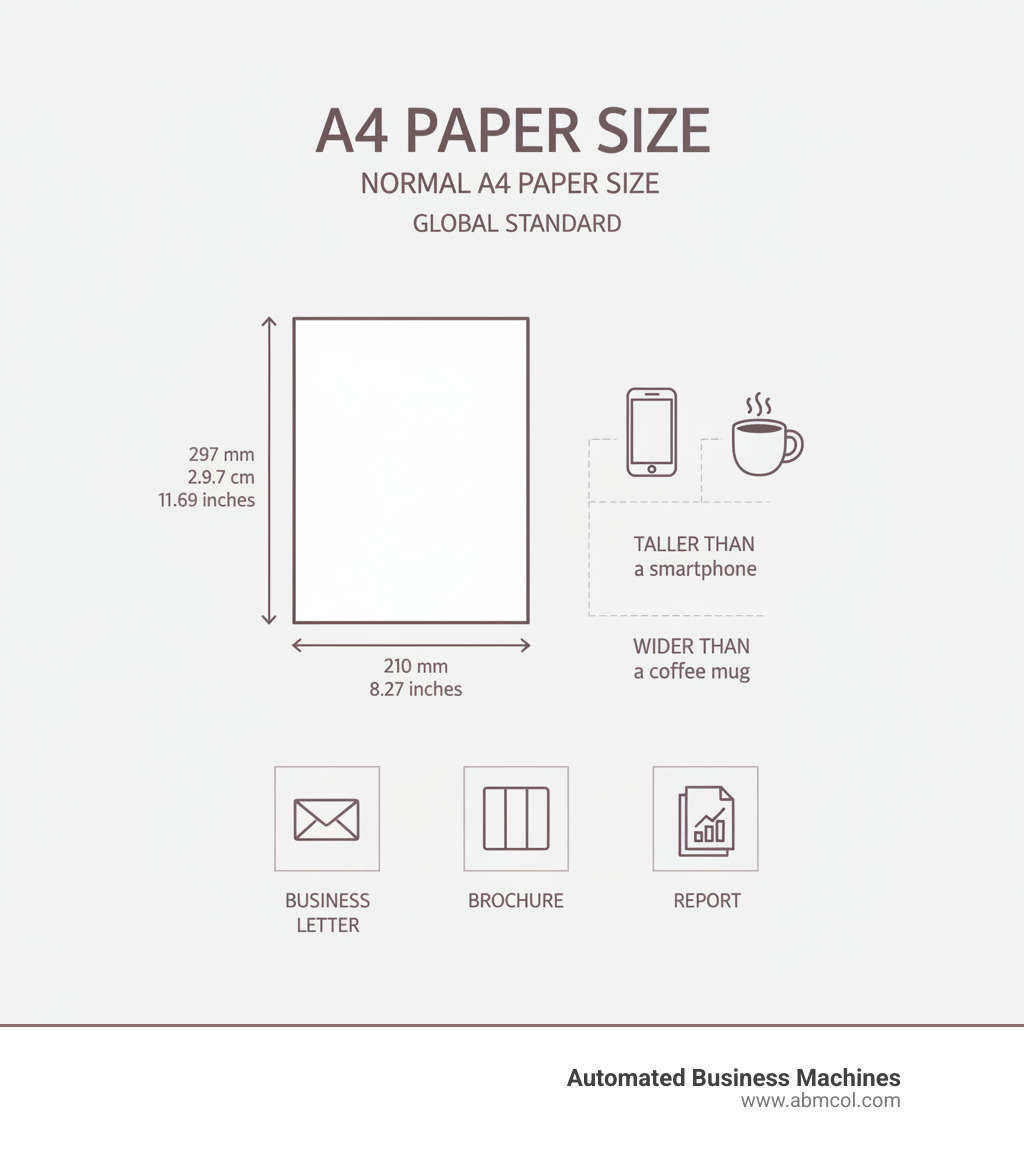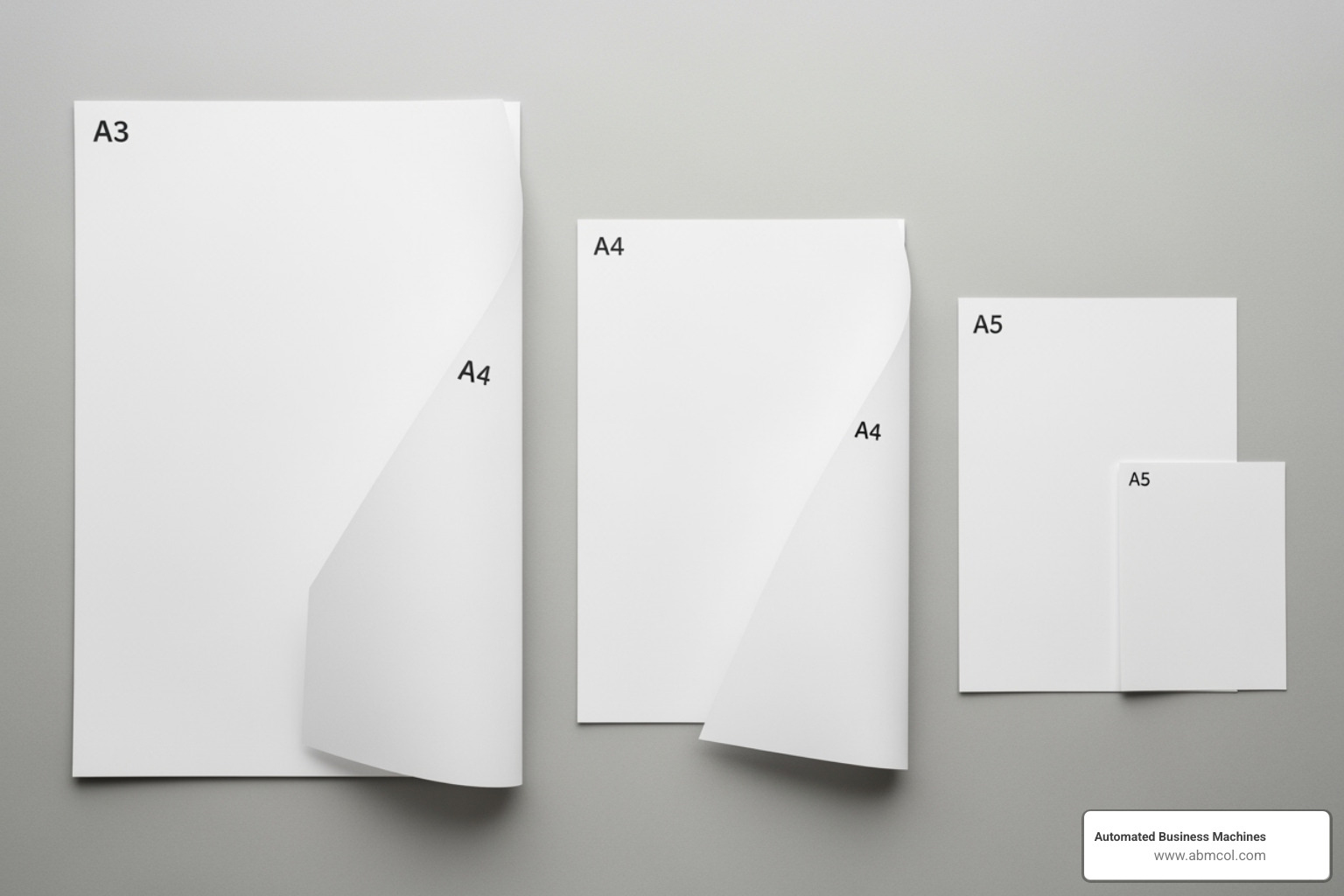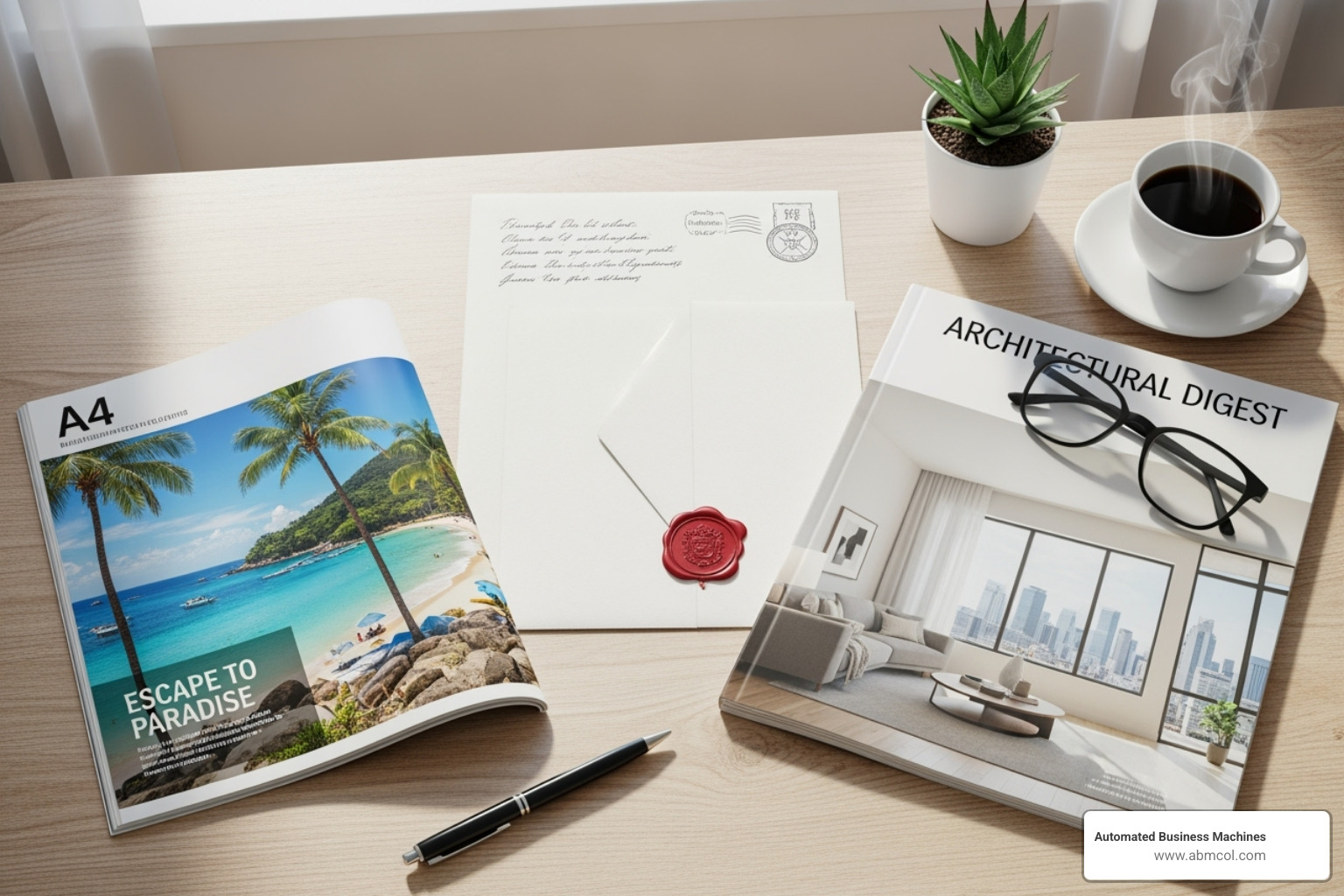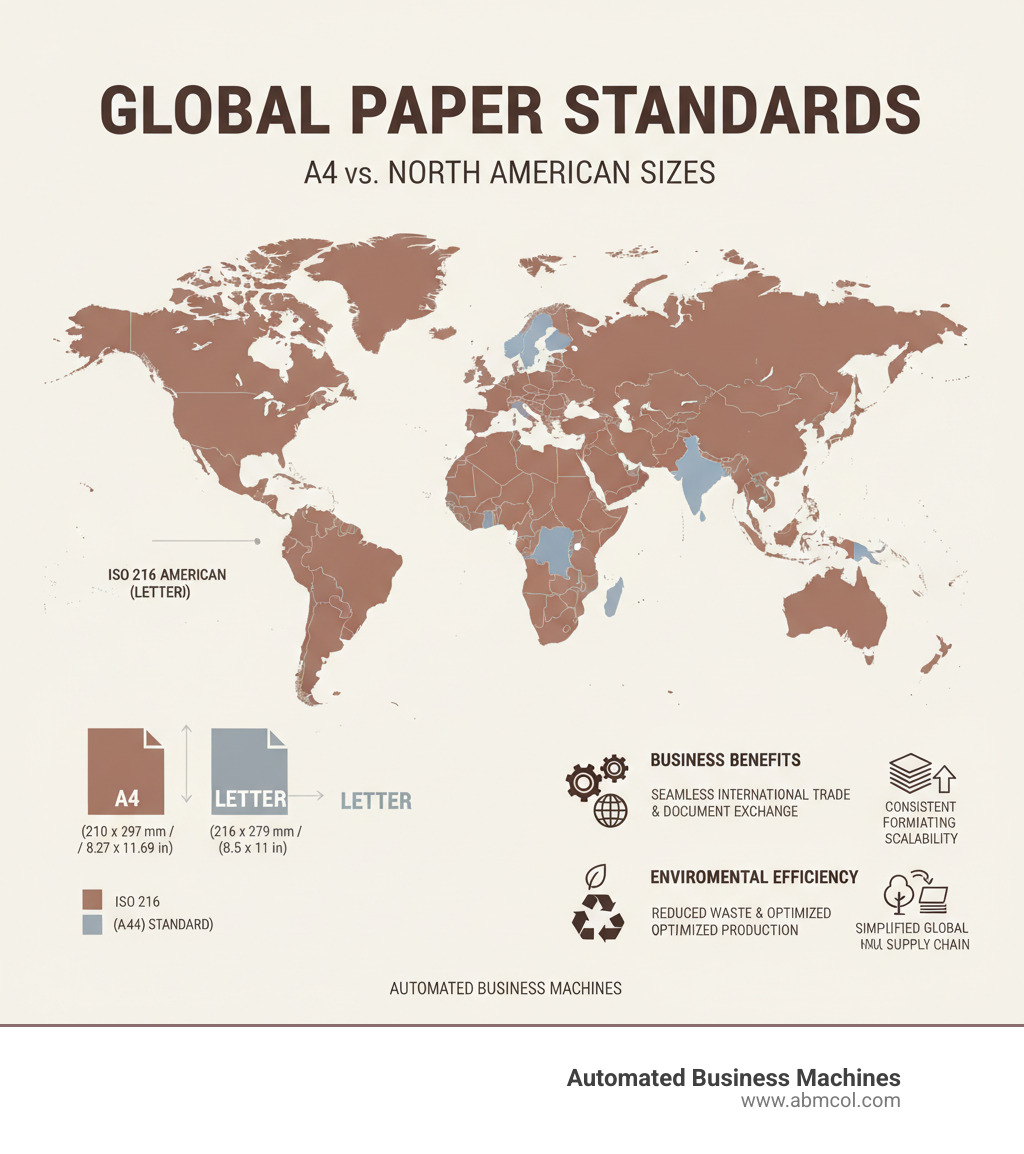
AI Overview:
Normal A4 paper size (210 × 297 mm or 8.27 × 11.69 in) is the global standard defined by ISO 216, used almost everywhere except the US and Canada. Its dominance comes from mathematical precision, international adoption, and practical efficiency in business, education, and publishing.
Why the Normal A4 Paper Size Dominates Global Business
Normal A4 paper size is the international standard measuring 210 x 297 millimeters (8.27 x 11.69 inches), used in nearly every country except the United States and Canada. This paper format is defined by the ISO 216 standard and serves as the backbone of global document exchange.
Quick A4 Paper Size Facts:
- Dimensions: 210mm x 297mm (8.27″ x 11.69″)
- Standard: ISO 216 international paper size system
- Aspect Ratio: √2:1 (approximately 1.414:1)
- Usage: Global standard except North America
- Area: 1/16 of a square meter
Whether you’re printing business letters, academic papers, or corporate brochures, A4 paper has become the de facto choice for office managers worldwide. Its mathematical precision allows documents to scale perfectly without distortion – fold an A4 sheet in half, and you get two A5 sheets with identical proportions.
This standardization matters more than you might think. When your company deals with international clients or suppliers, A4 ensures your documents print correctly on their equipment. No more cut-off text or awkward margins that scream “amateur hour.”
The genius behind A4 lies in its systematic design. Unlike the seemingly random dimensions of North American paper sizes, A4 is part of a logical family where each size relates mathematically to the others. This makes it incredibly efficient for printing, copying, and document management.
The Blueprint: Understanding the ISO 216 Standard
The story behind normal A4 paper size begins with one of the most neat mathematical solutions in office history. When you hold a sheet of A4 paper, you’re holding the result of centuries of thinking about how to make paper sizes actually make sense.
It all started with a simple but brilliant idea: what if paper sizes could scale perfectly without looking weird when you folded them? The ISO 216 standard was born from this concept, creating the A-series paper family that includes our trusty A4.
The mathematical magic happens with something called the aspect ratio – the relationship between a paper’s width and height. ISO 216 uses a ratio of 1:√2 (approximately 1:1.414), which sounds fancy but creates something amazing: when you fold any A-series paper in half, the two new pieces have exactly the same proportions as the original.
The system starts with A0, which covers exactly one square meter. Each smaller size is created by cutting the previous size in half along its longer edge. So A1 is half of A0, A2 is half of A1, A3 is half of A2, and A4 is half of A3. This halving principle means A4 is exactly one-sixteenth the size of that original square meter.
This isn’t just mathematical elegance for its own sake – it solves real business problems. When you need to scale a document from A4 to A3 for a presentation, or shrink it to A5 for a brochure, everything fits perfectly without awkward stretching or cropping.
The Genius of the A-Series Aspect Ratio
Here’s where things get really interesting. That √2 aspect ratio was actually finded way back in 1786 by Georg Christoph Lichtenberg, long before anyone was thinking about office printers. He called it Lichtenberg’s ratio, and it turns out to be the only ratio that maintains its proportions when you cut a rectangle in half.
Think about it this way: if you design a letterhead on A4 and later want to print it on A3 for a poster, you don’t need to redesign anything. The proportions stay identical, so your logo, text, and margins all scale perfectly. No stretching, no squishing, no headaches.
This consistency is a game-changer for printing efficiency. Whether you’re running a small office or managing print services for a large corporation, having paper sizes that work together seamlessly saves time and reduces errors. At Automated Business Machines, we see how this standardization streamlines our clients’ workflows.
For a deeper dive into why this matters for your business, check out our guide on Understanding A4 Paper Size.
Historical Roots of A4 Paper
The idea of standardized paper actually has origins – literally. During the French Revolution in 1798, officials wanted to standardize legal documents as part of their broader push to modernize and organize society. They proposed paper sizes based on mathematical ratios, though it took more than a century for the idea to really take hold.
The breakthrough came in 1922 when German engineer Walter Porstmann developed the DIN 476 standard in Germany. Porstmann took those French Revolutionary ideas and turned them into a practical system that German businesses and government offices could actually use.
The benefits were so obvious that other countries quickly jumped on board. By the 1950s, most of Europe had adopted the system. The International Organization for Standardization made it official as ISO 216, and even the United Nations chose A4 as their standard document format.
Today, virtually every country except the United States and Canada uses A4 as their standard letter size. It’s one of those rare examples of international cooperation actually working – when something makes this much sense, the whole world gets on board.
A4 by the Numbers: Dimensions and Global Comparisons
Let’s get down to the nitty-gritty: the exact measurements of normal A4 paper size. This is where the rubber meets the road, whether you’re designing a brochure or setting up your printer.
The A4 paper dimensions are precisely 210 mm x 297 mm in millimeters, which translates to 21.0 cm x 29.7 cm in centimeters, or 8.27 inches x 11.69 inches (approximately 8-1/4 x 11-3/4 inches) in the imperial system. These measurements aren’t arbitrary – they’re rounded to the nearest millimeter in the ISO 216 standard, ensuring perfect uniformity across manufacturers and regions worldwide.
What makes these numbers special? They’re the result of that magical √2 aspect ratio we discussed earlier. Every millimeter is calculated to maintain the mathematical relationship that allows A4 to scale perfectly with its paper size siblings.
A4 vs. North American Letter Size
Here’s where things get interesting – and sometimes frustrating! If you’ve ever tried to print a document from an international colleague on your US-based printer, you’ve likely encountered the subtle yet annoying difference between A4 and US Letter paper sizes.
While both serve as standard document formats, they come from completely different worlds. A4 belongs to the systematic, mathematically-derived ISO 216 standard, while US Letter is part of the North American ANSI standard, which evolved from historical printing practices rather than mathematical precision.
The key differences become clear when you compare them side by side:
| Feature | A4 Paper Size (ISO 216) | US Letter Size (ANSI) |
|---|---|---|
| Width (mm) | 210 mm | 215.9 mm |
| Height (mm) | 297 mm | 279.4 mm |
| Width (in) | 8.27 in | 8.5 in |
| Height (in) | 11.69 in | 11 in |
| Aspect Ratio | 1:√2 (1.414) | 1:1.294 (approx.) |
| Primary Usage | Most of the world | US, Canada, Philippines |
Notice how A4 is slightly narrower but notably taller than US Letter? This seemingly small difference can cause major headaches. Documents formatted for A4 might have text chopped off at the top or bottom when printed on Letter paper, or vice-versa. Margins look awkward, headers disappear, and your professional presentation suddenly looks amateur.
This is exactly why understanding these differences matters so much in our globalized business world. At Automated Business Machines, we help clients steer these formatting challenges every day. For deeper insights into paper size comparisons, check out our guides on Paper Size Legal vs A4 and Legal Size Paper vs Letter: Key Differences.
How A4 Relates to Other ISO Sizes
The beauty of the normal A4 paper size becomes even more apparent when you see how perfectly it fits into the larger ISO family. Think of it as a well-orchestrated symphony where every instrument knows its part.
A3 is exactly double the size of A4 – imagine placing two A4 sheets side-by-side along their longer edges, and voilà, you’ve created an A3 sheet. Going the other direction, A5 is precisely half the size of A4. Fold your A4 sheet once across its shorter dimension, and you get two perfect A5 sheets. This mathematical relationship continues seamlessly throughout the entire series.
The system works beautifully for practical applications. That large A1 poster for your trade show booth can be perfectly reduced to A4 handouts without any design distortion. The proportions remain identical, which is a designer’s dream and a printer’s best friend.
But the ISO system doesn’t stop at the A-series. The B-series serves as the middle ground – these sizes are the geometric mean between consecutive A-series sizes, perfect for books and posters where A-series might not offer the ideal dimensions. The C-series is specifically designed for envelopes, with C4 envelopes perfectly accommodating an unfolded A4 sheet, C5 envelopes fitting an A4 sheet folded once, and C6 envelopes holding an A4 sheet folded twice.
Here’s how the A-series family breaks down: A0 measures 841 mm x 1189 mm, A1 is 594 mm x 841 mm, A2 comes in at 420 mm x 594 mm, A3 is 297 mm x 420 mm, our familiar A4 at 210 mm x 297 mm, A5 at 148 mm x 210 mm, and A6 at 105 mm x 148 mm. Each size is exactly half the area of the previous one, creating a logical, efficient system that makes document management a breeze.
The Practical Guide to the Normal A4 Paper Size
Think of normal A4 paper size as the Swiss Army knife of the paper world. It’s incredibly versatile, surprisingly cost-effective, and – here’s something you might not have considered – it’s actually designed with human comfort in mind. The dimensions aren’t just mathematically neat; they’re also ergonomically sound for reading, writing, and handling.
The widespread global adoption of A4 creates a beautiful economic cycle. Because billions of sheets are produced worldwide, manufacturing costs stay low. This means whether you’re buying a ream in Tokyo or Toronto, you’re getting consistent quality at a reasonable price. Plus, A4’s size hits that sweet spot – large enough for substantial content, yet compact enough to fit comfortably in briefcases, filing cabinets, and even your hands when you’re reading on the go.
Common Uses for the Normal A4 Paper Size
Walk into any office around the world (except maybe in North America), and you’ll see A4 everywhere. It’s become the universal language of paper communication. Business documents like contracts, invoices, and quarterly reports naturally flow onto A4 pages, giving them a professional, internationally recognized appearance. When you send an A4 document to a client in Germany or Singapore, it prints perfectly on their equipment – no awkward scaling or cut-off text.
Letters and reports find their perfect home on A4. The dimensions provide enough space for formal letterheads, proper margins, and substantial content without feeling cramped. Students across Europe, Asia, and beyond grow up with A4 notebooks, making it second nature for academic work and note-taking.
The publishing world has acceptd A4 for magazines and textbooks, especially smaller-format publications. The proportions work beautifully for both text-heavy academic materials and image-rich magazines. Marketing professionals love A4 for brochures and flyers because of that magical folding property we discussed earlier – fold an A3 sheet once, and you have a perfect A4 brochure with consistent proportions.
Even for personal documents at home – whether you’re printing a recipe, a travel itinerary, or your child’s school project – A4 just works. It’s become so universal that most home printers outside North America are designed with A4 as the default setting. For more insights on choosing the right paper for your specific printing needs, check out our Standard Printer Paper Size Information.
Printing and Digital Design with the Normal A4 Paper Size
Here’s where things get interesting for anyone working with digital content. The normal A4 paper size translates differently into the digital world depending on what you’re planning to do with it.
When you’re preparing something for high-quality printing at 300 DPI, your A4 canvas becomes a substantial 2480 pixels by 3508 pixels. This resolution ensures your text stays crisp and your images look professional when they hit the paper. It’s the standard we recommend for business presentations, marketing materials, or anything that needs to make a great impression.
For screen viewing at 72 DPI, A4 shrinks down to 595 pixels by 842 pixels. This lower resolution is perfect for documents that will primarily be viewed on computers or tablets, and it keeps file sizes manageable for email attachments or web uploads.
Modern printers have gotten remarkably smart about handling different paper sizes, but knowing these pixel dimensions helps you create better-looking documents from the start. Our multifunction printers at Automated Business Machines can automatically detect paper sizes and adjust accordingly, but the best results always come from matching your document design to your intended paper size from the beginning.
The weight of your A4 paper matters too. Heavier paper (measured in GSM – grams per square meter) feels more substantial and professional, while lighter weights work perfectly for everyday printing and keep costs down. Understanding these nuances can make a real difference in how your documents are received. Our A4 Paper GSM Guide and Best Laser Printer Paper Types and Weights can help you choose the right paper for every situation.
Sometimes you’ll face tricky printing scenarios, like when you need to adapt documents between different paper standards. For those challenging moments, we’ve put together helpful resources like Print Legal Size Document on Letter Paper to keep your workflows running smoothly.
Frequently Asked Questions about A4 Paper Size
When it comes to normal A4 paper size, we get plenty of questions from our clients at Automated Business Machines. Paper sizes might seem straightforward, but the differences between international standards can create real headaches for busy office managers. Let’s clear up the most common confusion points we encounter.
Is A4 the same as 8.5 x 11 inches?
Here's where things get tricky - and it's probably the source of more printing frustrations than any other paper issue. No, A4 is definitely not the same as 8.5 x 11 inches. That 8.5 x 11 measurement is US Letter size, the standard across the United States and Canada.
Normal A4 paper size measures 8.27 x 11.69 inches (or 210 x 297 mm if you prefer metric). This means A4 is slightly narrower by about a quarter inch but noticeably taller by more than half an inch compared to US Letter.
You might think, "What's the big deal with such small differences?" Well, those seemingly minor variations can wreak havoc on your documents. Text gets cut off at the top or bottom, margins look wonky, and your professional presentation suddenly looks amateur. We've seen countless clients struggle with this exact issue when dealing with international partners or suppliers.
Why is A4 the standard paper size in most of the world?
The answer lies in brilliant mathematical design. A4 is the standard in most countries because it's part of the ISO 216 international paper size system - and this system is genuinely clever.
Unlike paper sizes that evolved from historical traditions (like US Letter), the ISO system is built on a rock-solid mathematical foundation: that magical aspect ratio of 1:√2 (approximately 1:1.414). This ratio creates something amazing - you can scale documents up or down without any distortion whatsoever.
Think about it this way: fold an A4 sheet in half, and you get two perfect A5 sheets with exactly the same proportions. Scale up from A4 to A3, and your design fits perfectly. This systematic approach eliminates waste, streamlines international business, and makes printing operations incredibly efficient.
When the world needed a unified standard for global trade and communication, the logical choice was clear. Even the United Nations adopted A4 for all official documents - that's quite an endorsement of its practical superiority.
Can I use A4 paper in a printer bought in the US?
Absolutely! This is great news for anyone dealing with international documents. Most modern printers, including the advanced multifunction solutions we provide, are designed to handle both US Letter and A4 paper sizes seamlessly.
Here's what you need to do to ensure perfect printing results:
First, adjust the paper guides in your printer's paper tray to snugly accommodate the A4 paper. These guides aren't just suggestions - they're crucial for proper paper feeding and preventing jams.
Second, and this is where many people stumble, select "A4" as your paper size in your print settings. This step is absolutely critical. You'll find this option in your computer's print dialogue box or within the specific software you're using.
Skip that second step, and you're asking for trouble. Your printer will try to squeeze your A4 document onto a Letter-sized template, potentially chopping off important text or creating those unprofessional-looking margins that make you want to hide under your desk.
Our multifunction printing solutions make this process even smoother with intelligent paper detection and automatic scaling features. But following these simple steps ensures your international documents print beautifully every time, maintaining that professional appearance your business deserves.
Conclusion
When you really think about it, the normal A4 paper size represents something quite remarkable – a global agreement on something as fundamental as the paper we write on. It’s not just about measurements; it’s about creating a universal language that makes business communication smoother, whether you’re printing a contract in Tokyo or mailing a brochure from Toronto.
The genius of A4 lies in that brilliant 1:√2 aspect ratio we explored earlier. This mathematical elegance means your documents always look proportional, no matter how you scale them. When you fold that A4 sheet in half, you get two perfect A5 sheets – not some awkwardly shaped rectangle that makes your content look squeezed or stretched. It’s this kind of thoughtful design that makes international business just a little bit easier.
Throughout our journey exploring A4, we’ve seen how its precise dimensions of 210 x 297 millimeters serve countless purposes. From the business reports that keep companies running to the school notebooks that educate the next generation, A4 quietly supports our daily communications. Its clear distinction from North American Letter size might seem like a small detail, but it’s these details that matter when you’re trying to make a professional impression with international partners.
The interconnected A-series family – with A3 being double A4 and A5 being half – along with the thoughtfully designed B and C series for specialized uses, shows how much planning went into creating this system. It’s not just about having different sizes; it’s about having sizes that work together harmoniously.
At Automated Business Machines, we’ve seen how proper paper handling can transform a business’s daily operations. Our multifunction printing solutions handle A4 and various other paper sizes effortlessly, because we know that when your documents look professional, your business looks professional too. Whether you’re dealing with local clients or international partners, having equipment that adapts to global standards like A4 keeps your workflows running smoothly.
Choosing A4 isn’t just about picking a paper size – you’re choosing to be part of a system that values consistency, efficiency, and global compatibility. When businesses increasingly operate across borders, that choice matters more than ever. To find all the paper options available for your specific business needs, take a look at our comprehensive Best Printer Paper Guide: Types and Sizes. And if you’re ready to optimize your entire document workflow, explore our Managed Print Services Benefits: Key Advantages – because great business relationships often start with great-looking documents.





